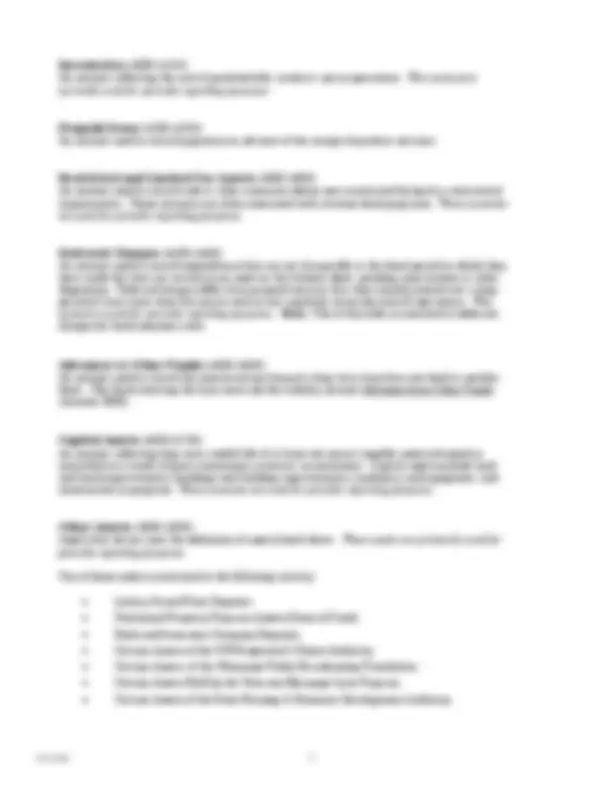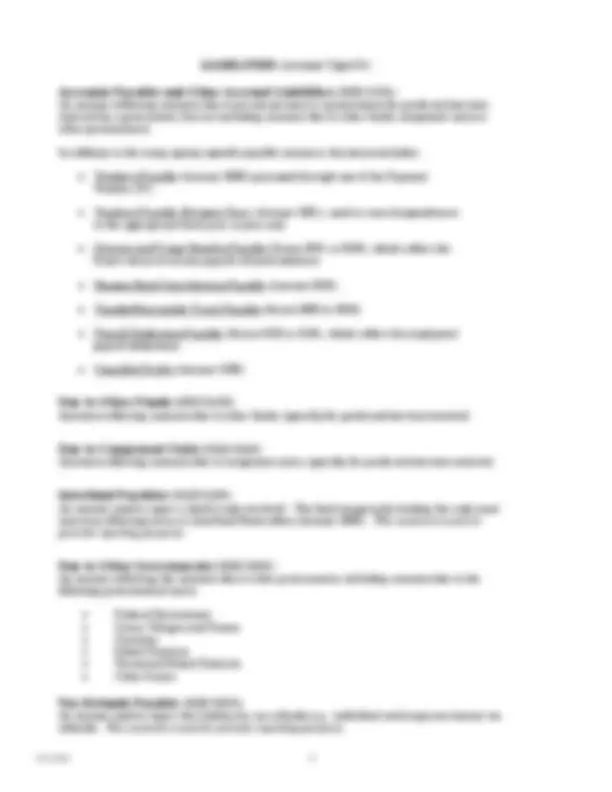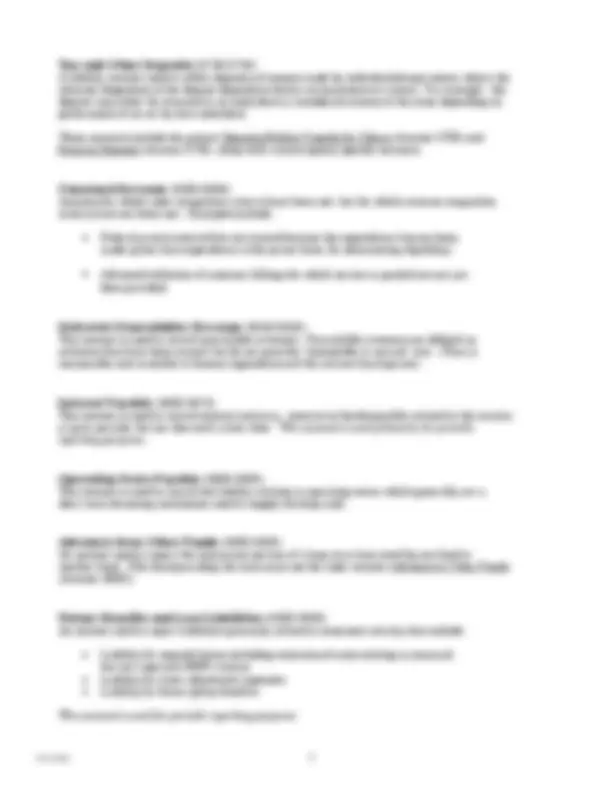





Study with the several resources on Docsity

Earn points by helping other students or get them with a premium plan


Prepare for your exams
Study with the several resources on Docsity

Earn points to download
Earn points by helping other students or get them with a premium plan
Community
Ask the community for help and clear up your study doubts
Discover the best universities in your country according to Docsity users
Free resources
Download our free guides on studying techniques, anxiety management strategies, and thesis advice from Docsity tutors
A balance sheet is a financial statement that discloses the assets ... sheet account titles and codes used on the central accounting system.
Typology: Exercises
1 / 7

This page cannot be seen from the preview
Don't miss anything!




An account reflecting currency, coin, checks, money orders and bankers' drafts on hand or on deposit with banks or other financial institutions. This account also includes cash equivalents, which are short-term, liquid investments that are both (a) readily convertible to known amounts of cash and (b) so near their maturity that they present insignificant risk of changes in interest rates (generally, only investments with original maturities of three months or less to the entity holding the investment).
Daily cash transactions are recorded to the account Treasurer's Cash (Account 1000). For example, Cash Receipts (CR's) automatically default to this account.
The account Investment Pool (Account 1100) is used to report each fund's share of the State Investment Pool. SCO adjusts the fund Investment Pool and Treasurer's Cash accounts daily to reflect the purchase or sale of investment pool shares as warranted by the fund’s cash transactions for the day. Per policy, on an individual fund basis, treasurer’s cash should equal less than $1000. All amounts over $1000 are invested in the investment pool where the holdings earn interest for any fund with a positive cash balance.
The contingent fund accounts Petty Cash (Account 1220), Change (Account 1230) and Checking (Account 1250) reflect the amounts authorized and remitted to agencies per State policy. Account 1280 Minimum Balance Requirement is used to record up to $500 in minimum cash deposits made into bank accounts to avoid monthly service charges. Entries are only made to these accounts when the amount authorized is increased or decreased. See State Accounting Manual, Volume I - Accounting Policies and Procedures, Section V - Expenditures, Sub-Section 9 - Contingent Funds, for further discussion on these types of transactions.
An account, which represents securities and real estate, held for the production of revenues in the form of interest, dividends, etc. Investments are generally long-term securities (i.e., having a maturity date greater than 90 days of the date acquired/purchased) typically held to maturity and redeemed.
An account reflecting amounts due from private persons or organizations for goods and services furnished by the state (but not including amounts due from other funds, other governments or component units). In addition to the many agency-specific receivable accounts, this series includes the generic:
Furthermore, the receivable accounts Travel Advance - Continuous (Account 3610) and Travel Advance - Occasional (Account 3615) should be used to record employee travel advances. Agencies should refer to Section V - 10 of the Manual for further guidance regarding the use of these accounts.
An account used to record amounts due from other funds, typically for goods and services rendered.
An account used to record amounts due from component units, typically for goods and services rendered.
An account to record amounts loaned from one fund to another to cover short-term cash
An account reflecting amounts due from another government, including amounts due from various units of governments including:
When establishing/accounting for the collection of receivables from other governments, agencies should utilize the appropriate account code in this account series.
An account reflecting amounts due to private persons or organizations for goods and services received by a government (but not including amounts due to other funds, component units or other governments).
In addition to the many agency-specific payable accounts, this series includes:
Accounts reflecting amounts due to other funds, typically for goods and services received.
Accounts reflecting amounts due to component units, typically for goods and services received.
An account used to report a fund's cash overdraft. The fund temporarily lending the cash must record an offsetting entry to Interfund Receivables (Account 3900). This account is used for periodic reporting purposes.
An account reflecting the amounts due to other governments, including amounts due to the following governmental units:
An account used to report the liability for tax refunds (e.g., individual and corporate income tax refunds). This account is used for periodic reporting purposes.
A liability account used to reflect deposits of moneys made by individuals/corporations, where the ultimate disposition of the deposit depends on future circumstances or events. For example: the deposit may either be returned to an individual or considered revenue of the state depending on performance of an act by that individual.
These accounts include the generic Deposits Held in Custody for Others (Account 5700) and Security Deposits (Account 5750), along with various agency-specific accounts.
Amounts for which asset recognition criteria have been met, but for which revenue recognition criteria have not been met. Examples include:
This account is used to record unavailable revenues. Unavailable revenues are defined as revenues that have been earned, but do not pass the “susceptible to accrual” test. (That is, measurable and available to finance expenditures of the current fiscal period.)
This account is used to record interest costs (e.g., interest on bonds payable) related to the current or prior periods, but not due until a later date. This account is used primarily for periodic reporting purposes.
This account is used to record the liability relating to operating notes, which generally are a short-term financing mechanism used to supply working cash.
An account used to report the noncurrent portion of a long-term loan owed by one fund to another fund. [The fund providing the loan must use the asset account Advances to Other Funds (Account 4500).]
An account used to report liabilities primarily related to insurance activity that include:
This account is used for periodic reporting purposes.
An account representing the State's investment in capital assets net of related debt. This account is used for periodic reporting purposes.
An account used to report the portion of equity whose use has been restricted by either externally or internally imposed constraints. This account may be used for periodic reporting purposes in proprietary, fiduciary or government-wide financial statements.
An equity account used to report the unconstrained portion of the accumulated resources of a proprietary or fiduciary fund. This account is also used for government-wide reporting purposes.
An account used to segregate the portion of the fund balance that is not appropriable for expenditure or that is legally segregated for a specific future use. These accounts include:
Many of the other fund balance - reserved accounts are also used for periodic reporting purposes.
An account used to report the portion of fund balance that has been set aside due to tentative plans for financial resource utilization in a future period.